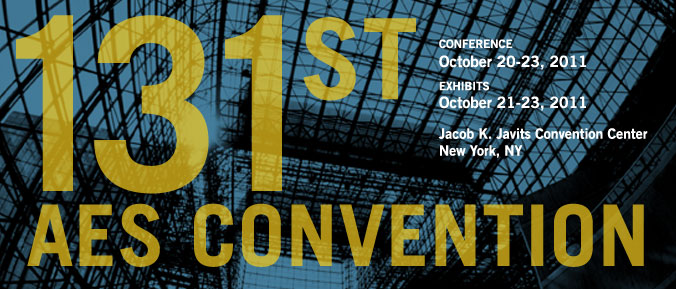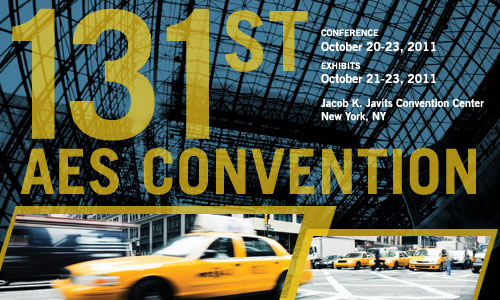
AES New York 2011
Paper Session P10
P10 - Transducers and Audio Equipment
Friday, October 21, 9:00 am — 12:00 pm (Room: 1E09)
Chair:
Juha Backman
P10-1 A Parametric Study of Magnet System Topologies for Miniature Loudspeakers—Holger Hiebel, Knowles Electronics Austria GmbH - Vienna, Austria, Graz University of Technology, Graz, Austria
This paper presents an overview of the results of a parametric study on miniature loudspeaker (microspeaker) designs. It compares a specific microspeaker design with fixed outer dimensions in three different electrodynamic magnet system topologies, namely the centermagnet, ringmagnet, and doublemagnet configurations. The study results are derived from simulations of the Bl-factor, moving mass, and effective radiating area with the voice coil inner diameter being the independent variable. Sound pressure level, electrical quality factor, and resonance frequency in a closed box were calculated and used to create easily understandable charts comparing the three topologies.
Convention Paper 8498 (Purchase now)
P10-2 A Computational Model of Vented Band-Pass Enclosure Using Transmission Line Enclosure Modeling—Jongbae Kim, Gyung-Tae Lee, Yongje Kim, Samsung Electronics Co., Ltd. - Suwon City, Gyeong-Gi Do, Korea
In order to predict low frequency performance of loudspeaker systems, the lumped parameter model is very useful. However, it doesn’t consider the enclosure geometry. Therefore, in some special cases, it makes a serious deviation between simulation and experimental results. According to the recent slim trend in IT devices, the majority of flat panel TVs and mobile devices adopt not only thin, long enclosures but also front radiating structure with waveguide. This loudspeaker system could be simplified as a vented band-pass enclosure. However due to the negligence of geometry, the effects of vent and driver location can't be considered. This paper discusses a computational model of the complicated vented band-pass enclosure using Backman’s low-frequency method for slim type band-pass enclosure models. Simulation results were compared with experimental results to verify the validity of the computational model.
Convention Paper 8499 (Purchase now)
P10-3 Nonlinear Viscoelastic Models—Finn T. Agerkvist, Technical University of Denmark - Lyngby, Denmark
Viscoelastic effects are often present in loudspeaker suspensions. This can be seen in the displacement transfer function that often shows a frequency dependent value below the resonance frequency. In this paper nonlinear versions of the standard linear solid model (SLS) are investigated. The simulations show that the nonlinear version of the Maxwell SLS model can result in a time dependent small signal stiffness while the Kelvin Voight version does not.
Convention Paper 8500 (Purchase now)
P10-4 Practical Applications of a Closed Feedback Loop Transducer System Equipped with Differential Pressure Control—Fabio Blasizzo - Trieste, Italy; Paolo Desii, Powersoft S.r.l. - Firenze, Italy; Mario Di Cola, Audio Labs Systems - Chieti, Italy; Claudio Lastrucci, Powersoft S.r.l. - Firenze, Italy
A closed feedback loop transducer system dedicated to very low frequency reproduction can be used in several different applications. The use of a feedback control loop can be very helpful to overcome some of the well known transducer limitations and to improve some of the acoustical performances of most of subwoofer systems. The feedback control of this system is based on a differential pressure control sensor. The entire system control is performed by a “Zero Latency DSP” application, specifically designed for this purpose in order to be able to process the system with real time performances. Practical applications to real world examples are being shown with design details and some test results.
Convention Paper 8501 (Purchase now)
P10-5 Dual Diaphragm Compression Drivers—Alex Voishvillo, JBL Professional - Northridge, CA, USA
A new type of compression driver consists of two motors, two diaphragm assemblies, and two phasing plugs connected to the same acoustical load (horn or waveguide). The annular flexural diaphragms are made of light and strong polymer film providing low moving mass. Unique configuration of the phasing plugs provides summation of both acoustical signals and direction of the resulting signal into a mutual acoustical load. Principles of operation of the dual driver are explained using a combination of matrix analysis, finite elements analysis, and data obtained from a scanning vibrometer. Comparison of performance of this drivers and conventional driver based on titanium dome diaphragm is performed. New transducer provides increase of powr handling, lower thermal compression, smoother frequency response, and decrease of nonlinear distortion and sub-harmonics.
Convention Paper 8502 (Purchase now)
P10-6 Distortions in Audio Op-Amps and Their Effect on Listener Perception of Character and Quality—Robert-Eric Gaskell, Peter E. Gaskell, George Massenburg, McGill University - Montreal, Quebec, Canada
Different operational amplifier topologies are frequently thought to play a significant role in the sonic character of analog audio equipment. This paper explores whether common audio operational amplifiers are capable of producing distortion characteristics within their normal operational range that can be detected by listeners and alter listener perception of character and quality. Differences in frequency response and noise are carefully controlled while the distortion characteristics of the op-amps are amplified. Listening tests are performed in order to determine what differences listeners perceive. Listening tests also examine listener preference for different op-amps for the purpose of exploring what physical measurements best predict differences in perceived audio character and quality.
Convention Paper 8503 (Purchase now)
Information Last Updated: 20111005, mei

